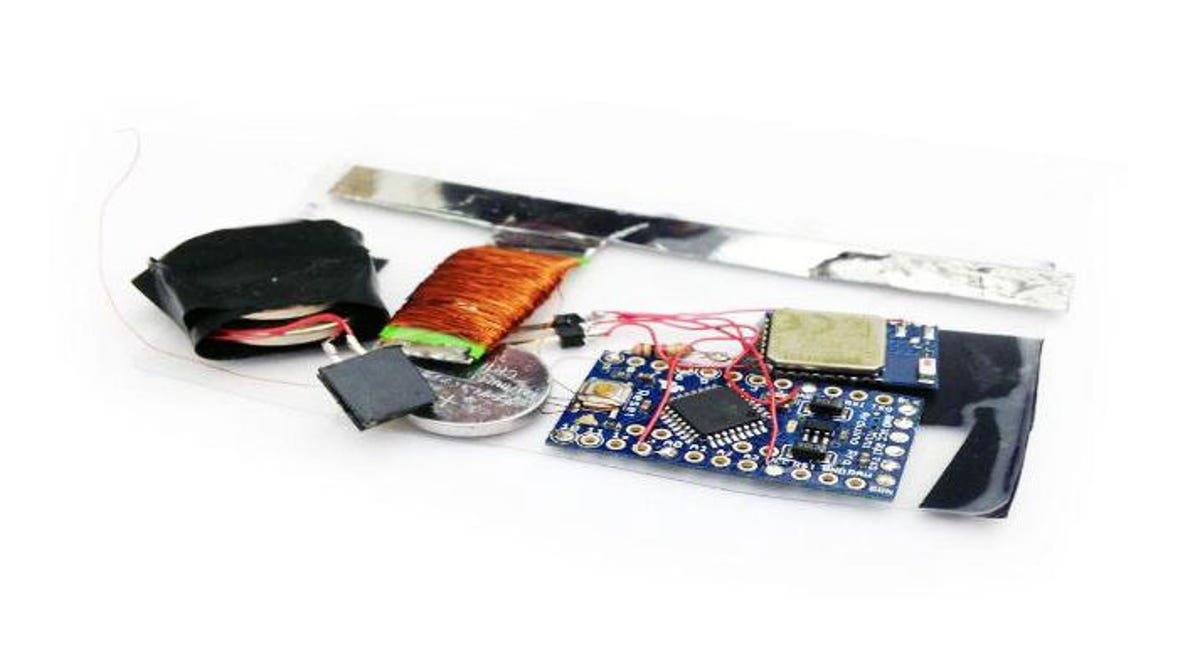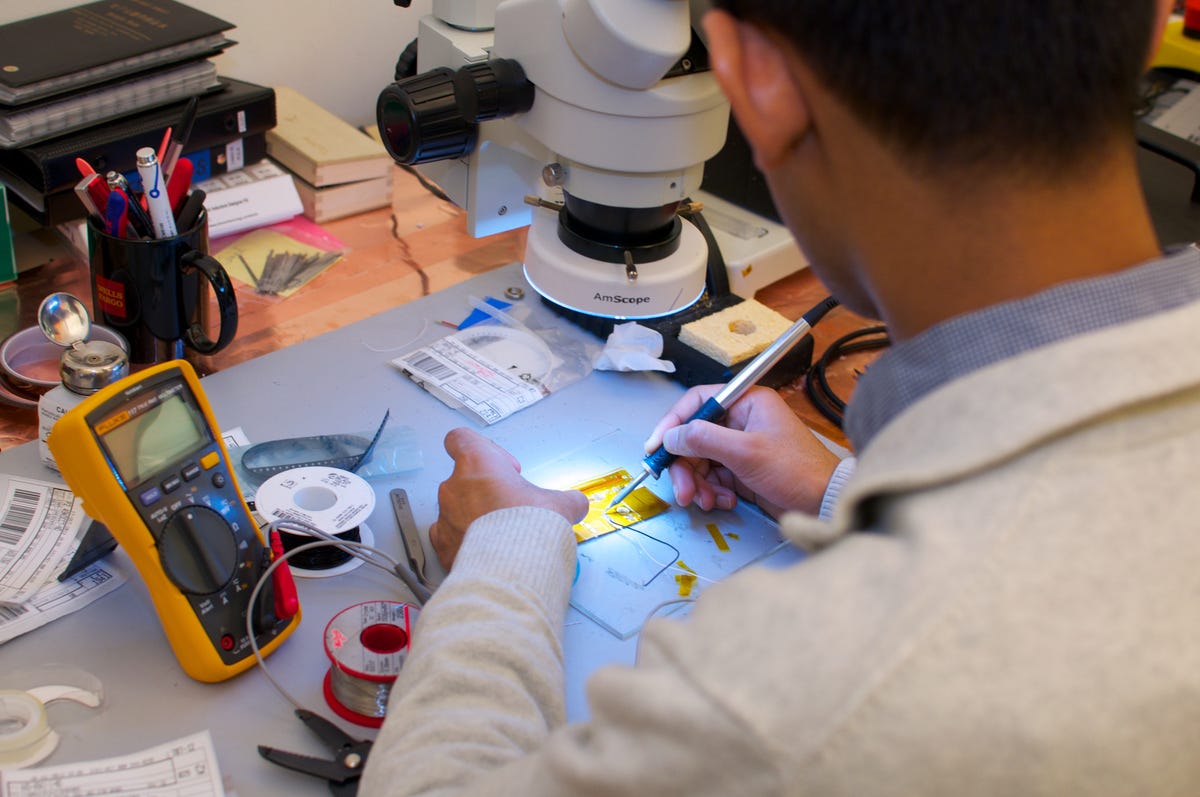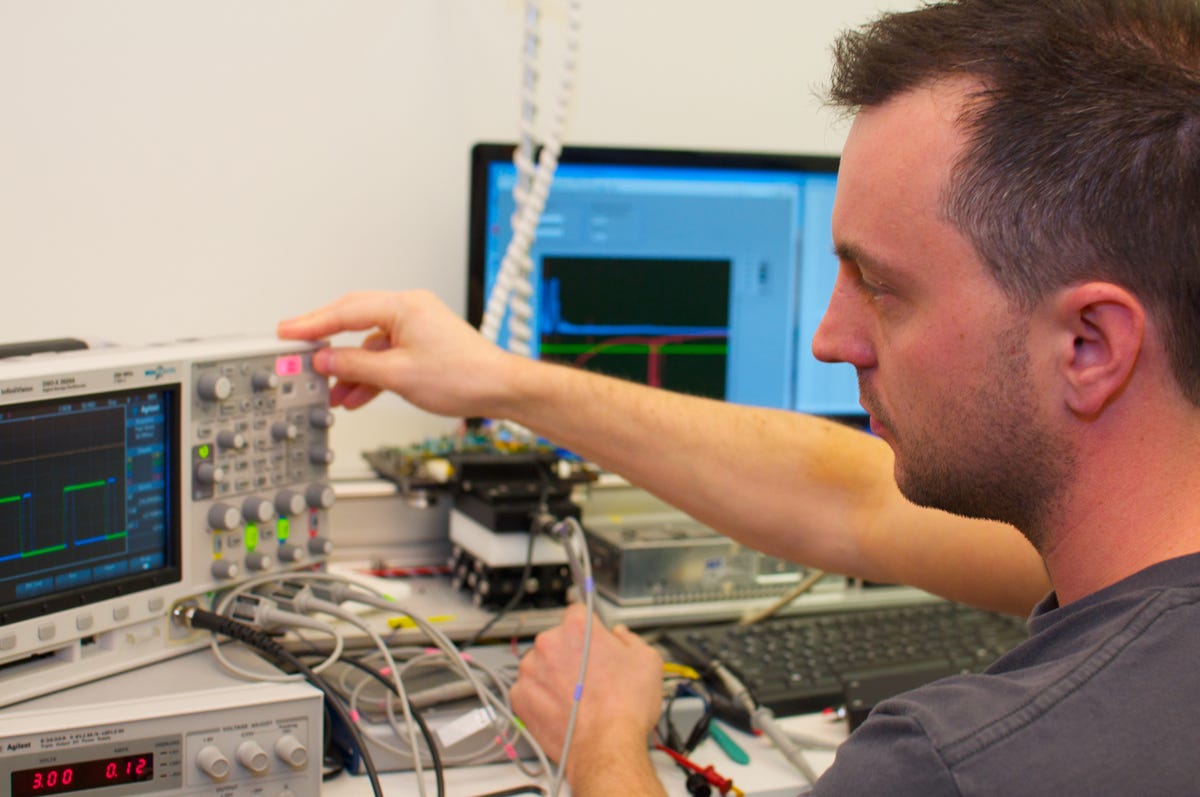In a compact San Francisco office suite equipped with soldering stations and swipe-testing machines, Coin’s team of seven has been working furiously to perfect the final prototype of an unlimited credit card. No, not one that will let you charge with abandon. Rather, a device as slim as a standard piece of payment plastic that can hold countless credit, debit, and gift cards in its dynamic magnetic stripe.
Kanishk Parashar, the CEO and founder of the Y Combinator-backed startup, embodies the effort-worn entrepreneur. “I got to work out today,” he said, eyeing the limited set of weights in the waterfront suite’s back room, a combination of a hangout and meeting room space adorned with a gigantic television and a beat-up original NES.
It was why he admitted to feeling a bit winded. Running a hardware startup means he doesn’t get much time for anything else. Yet he’s more animated as he glances over to a table lined with what look like flattened Raspberry Pi’s grafted to multicolored business cards.
“I built prototypes like this by hand,” Parashar said, holding out Coin’s first iteration. “It actually works. I was able to pay with this at restaurants.”


Coin
On Thursday, the team opened up its Web site for preorders as part of a crowdfunding campaign to raise $50,000. For $50, Coin is offering its fully finished card in black — “We call it midnight,” Parashar said — that it projects will last two years on a single charge when the team is done prototyping in two months. After the funding round, the device will go for $100.
The campaign will be Coin’s first trial out in the wild and Parashar has been focusing wholly on making sure that goes over smoothly. “We definitely want to make sure that the orders we get in we can actually satisfy,” he said on avoiding Kickstarter and all its reputation for ballooning hardware projects beyond their creators’ capacities. Delivery time is slated for summer of 2014.
The evolution of Coin, the all-in-one credit card (pictures)
.jpg?auto=webp&fit=crop&height=299&width=532)
.jpg?auto=webp&fit=crop&height=299&width=532)
.jpg?auto=webp&fit=crop&height=299&width=532)
.jpg?auto=webp&fit=crop&height=299&width=532)
.jpg?auto=webp&fit=crop&height=299&width=532)
.jpg?auto=webp&fit=crop&height=299&width=532)
That’s important as Coin has been a project in the making for more than a year and half, subsisting on Y Combinator and K9 Venture funding as well as the backing of former Google Wallet head Osama Bedier. Parashar has spent that time not only learning the ins and outs of managing a hardware startup, but also trying to overcome massive technological hurdles of building a device that can sturdily slip inside one’s wallet yet communicate with a smartphone through Bluetooth low energy, all while keeping sensitive financial data secure.
“The first six months that I started this company I spent learning hardware. I used textbooks, Google, Youtube, classes, and I built prototypes,” he said.


Nick Statt/CNET
The learning curve comes from his expertise in software. He’s held gigs at eBay and PayPal, and he founded a mobile-based commerce company Smart Market that would pull up customers’ pictures on an app and let people pay via smartphone, much in the same way Square Wallet works now. It did everything right, except offer an incentive to actually use it.
“We released the app and got a ton of downloads, but there were no payments going through our system,” he said. “Soon enough, we realized there were no merchants using it and so there were no consumers using it.” A lack of adoption on one end killed its chances on the other. “It was the chicken and the egg,” he added.
So Parashar turned to hardware, where the incentive is built-in. With Coin, merchants do nothing. On the user end, you simply load a card into Coin’s companion iOS or Android app by taking a photo of it, swiping it through Coin’s headphone jack dongle, and then toggling it on and off as you see fit while on the go. Paying with Coin involves squeezing a button on the card itself to turn it on and cycle to the desired card with the help of a small rectangular screen. Coin can then be swiped like any other card.
The Coin app can hold an unlimited number of cards, while the device itself can sync with up to eight for immediate use. Swapping cards in and out of Coin can be done in seconds on the go thanks to Bluetooth low energy connectivity, without needing the original piece of plastic.
“Coin eliminates one side of the fence,” Parashar said. “Whatever user gets a Coin, they’ll start using it everyday. The practical nature is massive.”
On the security side, Coin uses 128-bit and 256-bit encryption on both its server and mobile app, as well as on the card itself. The app will also communicate with your smartphone in the event you leave the Coin behind, letting you know you’ve forgotten it. If it loses contact with your phone for a self-designated amount of time, Coin will deactivate itself.
As for getting Coin into user’s hands, it won’t be as easy as calling overseas manufacturers and putting in an order. “We’re trying as much as possible to stay on-shore. We’d rather focus on delivery than lowering our cost,” Parashar said. That means maintaining a supply chain that — while containing foreign suppliers for hard-to-find parts — is mostly stateside and therefore more costly and the result of hard-earned contacts. “You can’t just Google it,” he added.
“We will directly use the crowdfunded campaign’s money to do manufacturing to buy the parts and to get the production lines ready so we can start producing higher quantities,” Parashar said.


Nick Statt/CNET
Still, manufacturing at a hardware startup is only the first phase of the battle. The payments space is not a place one enters lightly, and has many hardware competitors already deeply embedded in the market.
Twitter co-founder Jack Dorsey is said to be prepping Square for an IPO next year, and has led the charge in business-side mobile payment hardware and software with a slew of Square products, from iPad registers and iPhone readers to online marketplaces and email money transfer. Countless others, from Dwolla to Clinkle, are vying for a slice of a ripe market that’s continuously projected to explode over the course of the next decade.
As for whether or not Coin will be part of the inevitable future in which payments are all consolidated and likely done so on our smartphones, Parashar is not so much short-sighted as he is focused. “Right now the only thing I think about is delivering these and having them function,” he said. “When it comes to the future, we’ll make a decision based on where we lay in the land. But we pack all the technology inside Coin to generate next-generation experiences.”
Coin is hoping to slide itself into the space between a disruption-oriented company like Square and the paper and plastic world still governed by ATMs, Visas, and MasterCards. The startup and its product looks, feels, and operates thin enough to make that squeeze. Now it’s a matter of overcoming that chicken and the egg scenario that held Smart Market back, and getting users to actually begin swiping.
“That’s what we’re banking on,” Parashar said. “Adoption.”



